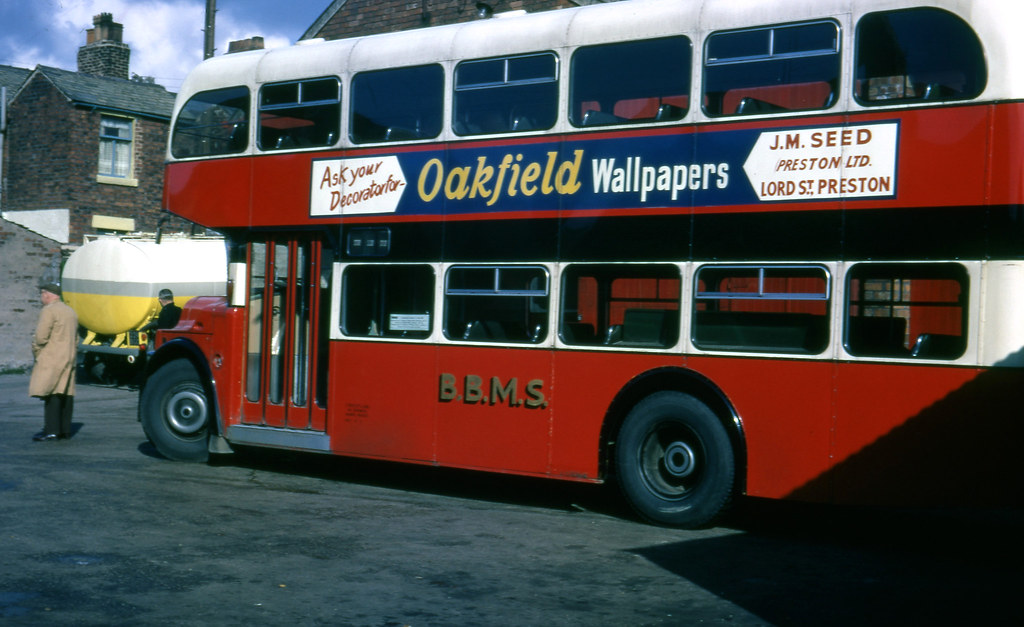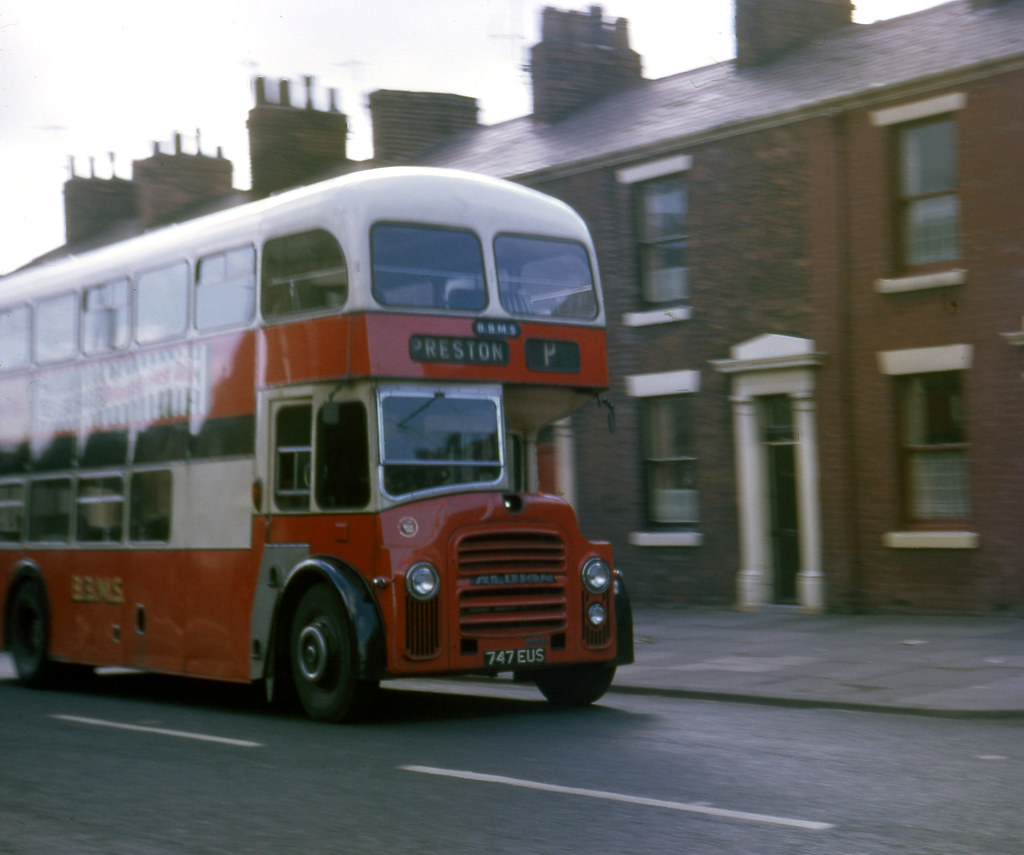Ray this PD 2 is in Lonsdale St Carlisle operating the Town Hall to Botcherby Estate service which just just recently been taken over by Ribble from United Automobile Services Carlisle depot operations circa 1965-6. They acquired all the Bristol single deckers but did not want the 3 Bristol KSW double deckers thus bring back MCW Orion bodied PD2s a type once very familiar with city services 1401 - 1425 open platform buses. new in 1955. The square looking building on the left of the bus with WESTERN sign board is the former Caledonian Omnibus Co bus station and garage now converted to a small shopping complex in the mid 1980s. All the WSMT services to Dumfries Langholm etc departed from the joint Ribble -■■■■■■■■■■ Lowther St bus station
the entrance/ exit hidden dehind the nearside rear corner of the PD2.
Cheers, Leyland 600
Ray if a number display like this one had been shown on a Carlisle depot bus you would have heard the chief inspector bawling the crew out down in Wigan !!! May be some kids had been fiddling with the winding handle and track selector which was behind the top deck front panel and accessible by opening two turnbuckles.
Cheers Leyland 600.

Surely some of you will idetify the single-decker on this picture taken at Parkend, Gloucestershire…
rogerfarnworth.com/2017/09/29/p … t-of-dean/
Hi Froggy, This bus in a Red & White Co of Cheptow Bristol MW with Eastern Coachworks 45 seat body probably fitted with a Gardner 5 or 6 HLW engine.
Cheers, Leyland 600.
Thanks! I love the scene, so British with the bus, Bedford TK, locomotive and typically British level crossing barriers!
Ribble Leyland PD3, Fleet No. 1974 was new to Scout Motor Services of Preston.
It is seen here beside Lime Street Station in Skelhorne Street, Liverpool, where
it was not very popular with the bus crews of whatever Ribble Liverpool depot
that it now belonged to.
Ray Smyth.

Leyland600:
Ray if a number display like this one had been shown on a Carlisle depot bus you would have heard the chief inspector bawling the crew out down in Wigan !!! May be some kids had been fiddling with the winding handle and track selector which was behind the top deck front panel and accessible by opening two turnbuckles.
Cheers Leyland 600.
Gerald…Yes, occasionally, schoolkids would mess about with the destination blinds and numbers.
During my time with Ribble, these older PD2 61 seaters were mainly used for works and school
journeys between 7 a.m, and 9 a.m. and later in the day between 4 p.m. and 6 p.m. and if there
was a problem with the destination blinds, they were not fixed for many days, unfortunately, some
bus crews were not particularly bothered what was showing on the front of the bus. I used to check
what my blinds were showing by checking the reflection in the rear window of a car or van ahead
of me in crawling traffic. Regards, Ray.
Why is it that in so many pictures of Leyland PD2s &3s they are leaning backwards? Other makes and models don’t seem to exhibit this to such an extent. They can’t all be carrying four Rugby teams. I thought that it was only the PD1s which had rubber suspension bushes.
Ray Smyth:
Ribble Leyland PD3, Fleet No. 1974 was new to Scout Motor Services of Preston.
It is seen here beside Lime Street Station in Skelhorne Street, Liverpool, where
it was not very popular with the bus crews of whatever Ribble Liverpool depot
that it now belonged to.
Ray Smyth.
I wonder why it ended up in Liverpool! Although it later came back to Frenchwood in its latter years
As you say, it started life with Scout Motors of Preston:
 Scout 21 [LRN62] by maljoe, on Flickr
Scout 21 [LRN62] by maljoe, on Flickr
When Scout was acquired (I think around 1962) the fleet received Ribble livery, but still with Scout names and numbers:
 RIB LRN62 by Brian Bennett, on Flickr
RIB LRN62 by Brian Bennett, on Flickr
Like many Scout vehicles, it survived long enough to suffer the indignity of NBC livery, and then ended up with an independent in Cornwall - must have been a long old delivery drive!!
Here’s the link to it, but the post doesn’t allow the image to be previewed on here: flickr.com/photos/30794964@ … sFy-u5EeL9
I don’t know which of the 3 Liverpool depots that Leyland PD3 1974 was from, Aintree, Bootle,
or Skelhorne Street. It wasn’t a popular machine because it was a Halfcab, which prevents
the driver being able to chat to his conductor and passengers.
In 1964 & 1965, Ribble Wigan depot received 5 new Albion Lowlanders, 1851,1852,1853.1854,& 1861.
During the 1970s, several more Albions of the original 16 were transferred to Wigan, and also Fleet No.
1968, the Albion Motors demonstrator from the early 1960s, which was a Halfcab, and just like 1974,
it was not popular with most buscrews.
An advantage of the full width cabs, PD3s, Atlanteans, and Albions, the conductor could pass the driver
a cup of coffee from his flask whilst on the move. ![]()
![]()
Ray Smyth.
Ray Smyth:
I don’t know which of the 3 Liverpool depots that Leyland PD3 1974 was from, Aintree, Bootle,
or Skelhorne Street. It wasn’t a popular machine because it was a Halfcab, which prevents
the driver being able to chat to his conductor and passengers.In 1964 & 1965, Ribble Wigan depot received 5 new Albion Lowlanders, 1851,1852,1853.1854,& 1861.
During the 1970s, several more Albions of the original 16 were transferred to Wigan, and also Fleet No.
1968, the Albion Motors demonstrator from the early 1960s, which was a Halfcab, and just like 1974,
it was not popular with most buscrews.An advantage of the full width cabs, PD3s, Atlanteans, and Albions, the conductor could pass the driver
a cup of coffee from his flask whilst on the move.
Ray Smyth.
And here it is:
 Lowlander Vs Fuel Tanker by jim_bbms, on Flickr
Lowlander Vs Fuel Tanker by jim_bbms, on Flickr
 BBMS No 6 on A6 Bamber Bridge by jim_bbms, on Flickr
BBMS No 6 on A6 Bamber Bridge by jim_bbms, on Flickr
 Untitled by Chris Roberts, on Flickr
Untitled by Chris Roberts, on Flickr
Ray Smyth:
I don’t know which of the 3 Liverpool depots that Leyland PD3 1974 was from, Aintree, Bootle,
or Skelhorne Street. It wasn’t a popular machine because it was a Halfcab, which prevents
the driver being able to chat to his conductor and passengers.In 1964 & 1965, Ribble Wigan depot received 5 new Albion Lowlanders, 1851,1852,1853.1854,& 1861.
During the 1970s, several more Albions of the original 16 were transferred to Wigan, and also Fleet No.
1968, the Albion Motors demonstrator from the early 1960s, which was a Halfcab, and just like 1974,
it was not popular with most buscrews.An advantage of the full width cabs, PD3s, Atlanteans, and Albions, the conductor could pass the driver
a cup of coffee from his flask whilst on the move.
Ray Smyth.
Funnily enough, i do not remember half cabs ever being particularly disliked with Birmingham crews. True a number of drivers at Selly Oak liked the Leyland Olympics ,i suspect as it gave them a chance to ‘chat up’ the customers,as they would be called these days.
Though a fan of the Birmingham standard, i must admit that the Albion Lowlander as a rugged purposeful look about it.
Looking at the Wrights Travel coaches, is ORR a Duple bodied Leopard? NAU, fitted with a B10M would be a flyer, and my choice to take up the road. Looks as if its fitted with a Plaxton body? Over to you Ray!
Paul John:
Looking at the Wrights Travel coaches, is ORR a Duple bodied Leopard? !
Computer says “no”, it’s a Bedford YNT ![]()
oiltreader:
Burlingham made some fabulous coachwork designs.
Paul John:
Looking at the Wrights Travel coaches, is ORR a Duple bodied Leopard? NAU, fitted with a B10M would be a flyer, and my choice to take up the road. Looks as if its fitted with a Plaxton body? Over to you Ray!
Yes, Paul John, It looks like a Plaxton Panorama Elite. Ray.
The Arriva bus with Wrights bodywork is possibly a Volvo, difficult to tell nowadays.
It has just left King Street, Wigan, from the right, and is about to enter King Street West,
on the left, to travel the last 400 yards to the new bus station. Route number 360 is
the journey from Warrington to Wigan.
Ray Smyth.
Some years ago (31 years ago, to be precise) I - a fairly newly-arrived backpacking Pommie in Oz on a short “working holiday” visa - got a job with a removals mob in Mascot (a southern suburb of Sydney, not a suitcase throw from Kingsford-Smith airport aka Sydney International). I regularly took either the 309 or the 310 service from Central Stn on a UTA (later STA) on one of these:
youtube.com/watch?v=ecobfR98Pco
Being a Pom, the noise it made was instantly familiar (an 0.600 Leyland) even if its coachwork looked… odd.
Footnote: at the time (1988) I had no reason to suspect that Sydney’s UTA (Urban Transit Authority, later STA, succeeded by Sydney Buses) had been one of Leyland (Truck & Bus) biggest overseas clients, having ordered north of 700 Leopard bus chassis. That Sydney UTA was, at the time, phasing in M-B O305s on almost every route is testament to Leyland’s obstinacy in offering only the O.500 engined National to its hitherto reliable export markets.
An ex Ribble Leyland Lion being taken to an apprentice school for re-build on
a Lancashire Fire Service Ford Cargo step frame artic, and a De-Icing machine
of British Airways, one of 7 from Manchester Airport, on a BRS Leyland DAF artic.
These operations were part of the varied work that the engineering department
of Ribble Motor Services carried out in the 1980s. Pictures by Ron Hopkins.
Ray Smyth.









